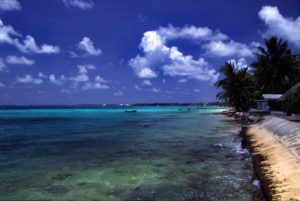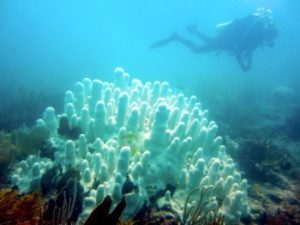by Eric Worrall, July 17, 2019 in WUWT
Who could have imagined that islands which survived rapid sea level rise at the end of the last ice age have no problem coping with changes in sea level?
Media Release
From: University of Auckland
Pacific atolls can adapt to rising seas and extreme storms – new study
Low-lying Pacific islands in atoll archipelagos such as Tuvalu, Tokelau and Kiribati are likely to adapt to the effects of climate change rather than simply sink beneath the waves, a new study shows.
Tuvalu, Tokelau and Kiribati are widely considered under threat from rising seas and severe storms due to climate change with their residents becoming ‘climate refugees’.
Researchers from the University of Auckland’s School of Environment recreated a scale model of tiny Fatato Island on the southeast rim of Funafuti Atoll in Tuvalu to test the ability of the real island to withstand predicted climate affects.
The study simulated higher sea levels and storm-generated waves up to 4m in a 20m-long water chute or ‘flume’ to replicate real-world sea levels of 0.5m and 1m in a purpose built laboratory at the University of Plymouth in the United Kingdom.
…

A beach at Funafuti atoll, Tuvalu, on a sunny day. Author Stefan Lins, source Wikimedia
by Zhao et al., 2019 in BMCPlantBiology/CO2Science
Recognizing that increasing atmospheric CO2 concentrations promotes plant development and growth, Zhao et al. set out to investigate the effect of elevated CO2 on a key wine grape variety, Pinot Noir.
Their experiment was conducted in controlled climate chambers at the Fruit Tree Physiology and Biotechnology Laboratory, College of Horticulture, Gansu Agricultural University, China. Grape plantlets (Vitis vinifera, cv. Pinot Noir) were propagated and then cultured in a 2% sucrose solution at either ambient (380 ppm) or elevated (1,000 ppm) CO2 concentrations for a period of 25 days. At the end of the experiment the authors examined the impact of CO2 on various growth-related parameters, while also conducting transcriptomic and proteomic analyses.
Results indicated that elevated CO2 stimulated total plant dry weight, leaf area and plant height by 125%, 96% and 31%, respectively (see Figure 1). Photosynthetic parameters also revealed a CO2-induced stimulation and the various physiological changes were found to be related to differentially expressed genes and proteins among the plants growing in the two environments. Such findings suggest Pinot Noir may well be a “winner” (in terms of growth and development) among plants in the future if the air’s CO2 content continues to rise.

Figure 1. Visual display of the growth differences between grapes grown under ambient (380 ppm) or elevated (1,000 ppm) CO2 concentrations for 25 days. The average dry weight of the grapes growing under elevated CO2 was 125% greater than those growing under ambient CO2. Source: Zhao et al. (2019).
by Brook Hays, July 16, 2019 in ClimateChangeDispatch
Corals are disappearing across the world’s oceans, and most scientists have pointed to warming water temperatures — the result of climate change — as the primary driver.
But new research suggests nitrogen pollution is the main cause of coral bleaching in Florida.
The study, published this week in the journal Marine Biology, was compiled using the three-decades worth of observational data collected at the Looe Key Reef in the lower Florida Keys.
“Our results provide compelling evidence that nitrogen loading from the Florida Keys and greater Everglades ecosystem caused by humans, rather than warming temperatures, is the primary driver of coral reef degradation at Looe Key Sanctuary Preservation Area,” lead study author Brian Lapointe, research professor at Florida Atlantic University’s Harbor Branch Oceanographic Institute, said in a news release.
Data collected at the test site showed nutrient runoff has boosted the nitrogen-phosphorus ratio in reef algae.
As more and more treated sewage and fertilizers from commercial farms rinse into local waterways and flood the oceans with nutrients, including reactive nitrogen, corals are unable to absorb sufficient levels of phosphorous.
“Our results provide compelling evidence that nitrogen loading from the Florida Keys and greater Everglades ecosystem caused by humans, rather than warming temperatures, is the primary driver of coral reef degradation at Looe Key Sanctuary Preservation Area,” lead study author Brian Lapointe, research professor at Florida Atlantic University’s Harbor Branch Oceanographic Institute, said in a news release.
…

La géologie, une science plus que passionnante … et diverse



